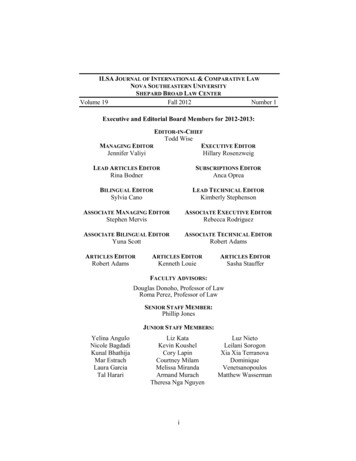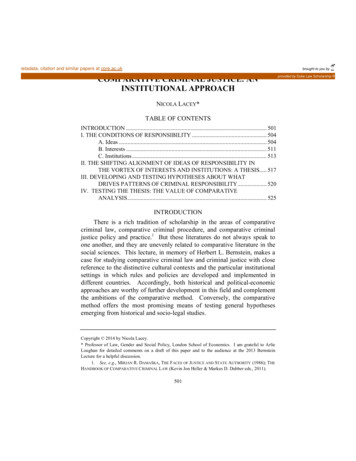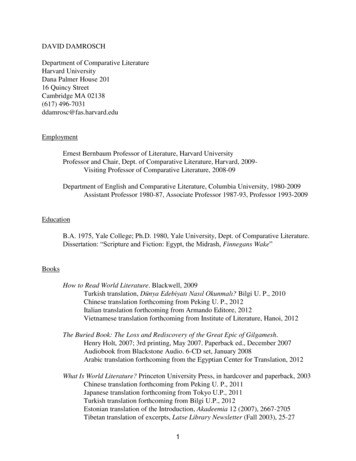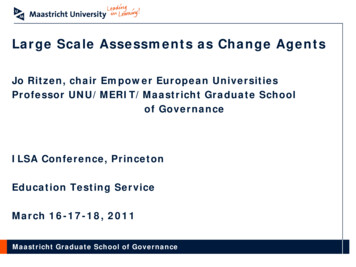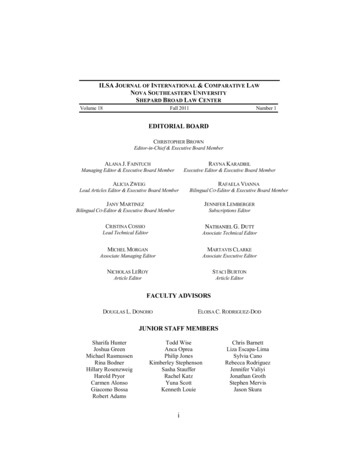
Transcription
ILSA JOURNAL OF INTERNATIONAL & COMPARATIVE LAWNOVA SOUTHEASTERN UNIVERSITYSHEPARD BROAD LAW CENTERVolume 18Fall 2011Number 1EDITORIAL BOARDCHRISTOPHER BROWNEditor-in-Chief & Executive Board MemberALANA J. FAINTUCHRAYNA KARADBILManaging Editor & Executive Board MemberExecutive Editor & Executive Board MemberALICIA ZWEIGRAFAELA VIANNALead Articles Editor & Executive Board MemberBilingual CO-Editor & Executive Board MemberJANY MARTINEZJENNIFER LEMBERGERBilingual CO-Editor & Executive Board MemberSubscriptions EditorCRISTINA COSSIONATHANIEL G. DUTTLead Technical EditorAssociate Technical EditorMICHEL MORGANMARTAVIS CLARKEAssociate Managing EditorAssociate Executive EditorNICHOLAS LEROYSTACI BURTONArticle EditorArticle Editor FACULTY ADVISORSDOUGLAS L. DONOHOELOISA C. RODRIGUEZ-DODJUNIOR STAFF MEMBERSSharifa HunterJoshua GreenMichael RasmussenRina BodnerHillary RosenzweigHarold PryorCarmen AlonsoGiacomo BossaRobert AdamsTodd WiseAnca OpreaPhilip JonesKimberley StephensonSasha StaufferRachel KatzYuna ScottKenneth LouieiChris BarnettLiza Escapa-LimaSylvia CanoRebecca RodriguezJennifer ValiyiJonathan GrothStephen MervisJason Skura
NOVA SOUTHEASTERN UNIVERSITYSHEPARD BROAD LAW CENTERADMINISTRATIONAthornia Steele, B.A., J.D., Dean of the Law School & Professor of LawLeslie Larkin Cooney, B.S., J.D., Associate Dean for Academic Affairs & Professorof LawJosh Metz, B.S., B.S., B.A., C.P.A., Director of Finance and AdministrationCatherine Arcabascio, B.A., J.D., Associate Dean for International, Online andGraduate Programs and Professor of LawJennifer McIntyre, B. S., M.S., Assistant Dean for Online ProgramsJanet Mosseri, B.S., J.D., Associate Director for Student AffairsLynn Acosta, B.A., M.S., Assistant Dean for Student ServicesWilliam Perez, B.A., Assistant Dean for AdmissionsLinda F. Harrison, B.A., J.D., Associate Dean, Critical Skills Program & AssociateProfessor of LawBernadette Carnegie Baugh, B.S., M.S.M.F.T., Administrative Director, CriticalSkills ProgramNancy Kelly Sanguigni, B.S., M.B.A., Assistant Dean for Clinical ProgramsRobert Levine, B.S., J.D. Assistant Dean of Career Development, & AdjunctProfessorJennifer Jarema, B.A., M.S., Director of Communication and, Publications & SpecialEventsDoug Kruse, B.A., M.S., Director of DevelopmentEric Young, B.A., M.L.S., J.D., Director Law Library & Technology Center, Headof Information Services and Assistant Professor of LawFACULTYJohn B. Anderson, B.A., J.D., LL.M., Distinguished Visiting Professor of LawCatherine Arcabascio, B.A., J.D., Associate Dean, International Programs andProfessor of LawTimothy Arcaro, B.S., J.D., Academic Director AAMPLE and Online Programs, andProfessor of LawHeather Baxter, B.A., J.D., Assistant Professor of LawBrion Blackwelder, B.S., J.D., Director, Children & Families Clinic & AssociateProfessor of LawRonald Benton Brown, B.S.M.E., J.D., LL.M., Professor of LawRandolph Braccialarghe, B.A., J.D., Professor of LawBarbara Britzke, M.A.T., J.D., LL. M, Critical Skills Program InstructorJohnny C. Burris, B.G.S., J.D., LL.M., Professor of LawMarilyn Cane, B.A., J.D., Professor of LawKathy Cerminara, B.S., J.D., LL.M., Professor of LawMeg Chandelle, B.S., M.B.A., J.D., Director of Advanced Lawyering Skills & Values& Adjunct Professor of LawDavid R. Cleveland, B.A., J.D., Associate Professor of Lawii
Phyllis G. Coleman, B.S., M.Ed., J.D., Professor of LawLeslie Larkin Cooney, B.S., J.D., Associate Dean of Academic Affairs and Professorof LawJane Ellen Cross, B.A., J.D., Director of Caribbean Law Programs and AssociateProfessor of LawDebra Moss Curtis, B.A., J.D., Professor of LawMichael J. Dale, B.A., J.D., Professor of LawMark Dobson, B.A., J.D., LL.M., Professor of LawDouglas Lee Donoho, B.A., J.D., LL.M., Professor of LawOlympia Duhart, B.A., J.D., Associate Professor of LawLynn A. Epstein, B.S., J.D., Professor of LawMichael Flynn, B.A., J.D., Professor of LawAmanda Foster, B.A., J.D., Associate Professor of LawPearl Goldman, B.C.L., M. Phil., LL.B., J.D., LL.M., Professor of LawColleen Grady, M.S., Ed., J.D., Critical Skills Program InstructorRobert Gregg, J.D., Critical Skills Program InstructorJoseph M. Grohman, B.A., M.A., J.D., Professor of LawRichard Grosso, B.S., J.D., Director, Environmental & Land Use Law Clinic andAssociate Professor of LawGwen Thayer Handelman, B.A., J.D., Scholar in ResidenceJoseph D. Harbaugh, B.S., J.D., LL.B., LL.M., Dean Emeritus & Professor of LawLinda F. Harrison, B.A., J.D., Associate Dean, Critical Skills Program & AssociateProfessor of LawJoseph Hnylka, B.A., J.D., Assistant Professor of LawAreto Imoukhuede, B. A., J.D., Associate Professor of LawRobert M. Jarvis, B.A., J.D., LL.M., Professor of LawAlicia Jackson, M.P.A., J.D., Critical Skills Program InstructorJudith Karp, B.A., M.L.S., J.D., Professor of LawShahabudeen Khan, B.S., J.D., Assistant Professor of LawIshaq Kundawala, B.A., J.D., Associate Professor of LawP. Camille Lamar, B.A., J.D., Associate Professor of LawElena Langan, B.A., J.D., Director of First Year LSV Program and AssociateProfessor of LawRobert C. Levine, B.S., J.D., Assistant Dean, Career Services & Adjunct Professorof LawJames B. Levy, B.A., J.D., Associate Professor of LawKenneth Lewis, B.A., J.D., Assistant Professor of LawDonna Litman, A.B., J.D., Professor of LawElena Marty-Nelson, B.A., J.D., LL.M., Professor of LawMichael R. Masinter, B.A., J.D., Professor of LawJani E. Maurer, B.A., J.D., Professor of LawHoward Messing, A.B., J.D., Professor Emeritus of LawJoel A. Mintz, B.A., J.D., LL.M., J.S.D., Professor of LawHugh Mundy, B.A., J.D., Assistant Professor of LawHeddy Muransky, B.A., M. Ed., J.D., Critical Skills Program InstructorTimothy A. O’Brien, B.A., M.A., J.D., Distinguished Visiting Professor of LawRoma Perez, B.A., J.D., Associate Professor of LawPouncy, Charles, B.A., J.D., LL.M., Distinguished Visiting Professor of LawPatricia Murphy Propheter, M.A. Ed., J.D., Critical Skills Program InstructorRodney Rawls, J.D., LL. M., Critical Skills Program InstructorGail Levin Richmond, A.B., M.B.A., J.D., Professor of Lawiii
Michael L. Richmond, A.B., M.S.L.S., J.D., Professor of LawEloisa C. Rodriguez-Dod, B.B.A., M.B.A., J.D., Professor of LawBruce S. Rogow, B.B.A., J.D., Professor of LawMarc Rohr, B.A., J.D., Professor of LawRaul Ruiz, B.A., J.D., Critical Skills Program InstructorJohn Sanchez, B.A., J.D., LL.M., Professor of LawFlorence Shu-Acquaye, LL.B., LL.M., J.S.M., J.S.D., Professor of LawCharlene Smith, B.A, M.A., J.D., LL.M., Professor of LawAthornia Steele, J.D. Dean and Professor of LawMichele Struffolino, M.A Ed., JD., Assistant Professor of LawFran L. Tetunic, B.A., J.D., Director, Alternative Dispute Resolution Clinic &Associate Professor of LawKathryn Webber, B.A., J.D., Assistant Professor of LawJames D. Wilets, B.A., M.A., J.D., Professor of LawTania Williams, B.A., J.D., LL. M., Critical Skills Program InstructorSteven Wisotsky, B.A., J.D., LL.M., Professor of LawEric Young, B.A., M.L.S., J.D. Assistant Dean for Law Library and TechnologyServices/Assistant Professor of LawADJUNCT FACULTYScott Atherton, B.S., J.D.Ross Baer, B.A., J.D.Steve Ballinger, B.A., J.D.Courtney Bannan-Strader, B.S., J.D.Roshawn Banks, B.S., J.D.Lorna Banister, B.S., J.D.Marilyn Batista-McNamara, B.S., J.D.Leyza Blanco, B.A., J.D.Gabrielle Bouza, B.S., J.D.Mark Bromley, B.S., J.D.Dale A. Bruschi, B.S., J.D.Robert Campbell, B.A., J.D., M.P.H.,Ph.D.Lydia Cannizzo, B.H.S., J.D.Meg Chandelle, B.S., M.B.A., J.D.Michele Chang, B.A., J.D., M.H.A.Judith Chorlog, B.S., J.D.Howard Citron, B.S., J.D.Steven M. Collard, B.A., M.Ed.Michael Constantino, B.A., J.D.Christopher Crane, B.S., J.D.Charles Curtis, B.S., J.D.Arthur Ted Daus, B.A., J.D.Morton A. Diamond, B.A., M.D.ivNeil Karadbil, B.A., J.D.Ken Kugler, B.A., J.D.Warren Kwavnick, B.C., J.D.Barbara Landau, B.A., J.D., LL.M.Steven Leigh, B.S., M.S., J.D., Ph. D.Allan M. Lerner, B.A., J.D.Robert Levine, B.S., J.D.James Lewis, B.A., J.D.Juan Lopez-Campillo, B.A., J.D.,LL.M.Rochelle Marcus, B.S., M.ED., J.D.Lisa A. McNeils, B.A., J.D.Catherine M. Michael, B.A., J.D.Elena R. Minicucci, B.A., J.D.Seema Mohapatra Reddy, B.A.,M.P.H.,Kenneth Morgan, Jr., B.A., J.D.Alberto Moris, B.A., J.D.Gerald Morris, B.A., J.D.Charles Morton, B.A., J.D.John Napolitano, B.A., J.D.Matthew Nelles, B.S., J.D.Alice Nelson, B.A., M.S.W., J.D.Paul A. Nidich, B.A., J.D., LL.M.William Nortman, B.A., J.D.
Mark Nurik, B.A., J.D.Elizabeth Pendo, B.A., J.D.Laura Pincus, B.A., M.A., J.D.Gary A. Poliakoff, B.S., J.D.Vanessa Prieto, B.A., J.D.Rachael Ricci, B.A., J.D.Israel Reyes, A.A., B.S., J.D.Rebecca Rich, A.B., J.D., M.S.Christine Rickard, B.A., J.D.H. John Rizvi, B.S., J.D.Michael Rocque, B.A., J.D.Jose A. Rodriguez-Dod, B.S., J.D.Denise Roland, B.A. J.D.Jon Rosenthal, B.A., J.D.Diana Santa Maria, B.A., J.D.Jessica Santiago, B.A., J.D.Philip G. Schlissel, B.A., J.D.Carl Schoeppl, B.S., J.D.Adam Schulman, B.A., M.S., Ph.D.Robert Schwartz, B.A., J.D.Neal Shniderman, B.A., J.D.Jodi Siegel, B.A., J.D.Robert F. Diaz, A.A., B.A., J.D.Ken S. Direktor, B.A., J.D.Susan Dubow, B.S.Rebecca Feinberg, B.A., J.D.Jane Fishman, B.A., J.D.Luis Font, J.D.Rex J. Ford, B.S., J.D.Steve Friedland, B.A., J. D., LL. M.,J.S.D.John A. Frusciante, B.A., M.S., J.DMyrna Galligano, B.A., J.D.Jason Glusman, B.A., J.D.Stuart Gold, B.A., J.D.Adam S. Goldberg, B.S., J.D., LL.M.Anthony Gonzalez, B.A., J.D.Robert C. Grosz, B.A., M.S., Ed.D.Tonja Haddad, B.A., J.D.Ross Hartog, B.S., J.D.Robert Hartsell, B.A., J.D.Ann Hesford, B.A., J.D.Douglas F. Hoffman, B.S., B.A., J.D.Alfred Horowitz, B.A., J.D., LL.M.Julie Hough, B.A., J.D.Jacqueline Howe, B.A., J.D.Cynthia Imperato, B.S., M.S., J.D.William Isenberg, B.A., J.D.Yasmin Jacob, B.A., J.D.Judith Jarvis, B.A., J.D.Linnea Johnson, B.A., J.D.Nick Jovanovich, B.S., J.D., LL.MNorman Kaplan, B.S., J.D., LL.M.Daniel L. Kaufman, B.S., J.D.Phyllis Kotey, B.A., J.D., M.A.Pamela Krauss, B.S., M.S., J.D.Ira Kurzban, B.S., J.D.Samuel Smargon, Ph.D., J.D.Scott Smiley, B.S., J.D.Mindy Solomon, B.S., J.D.Richard Stone, B.A., J.D.Frank Terzo, B.A., J.D.Debbie Thaler, B.A., J.D.Ellen S. Tilles, B.A., M.S.W., Ed.S.,J.D.Damian Thomas, B.B.A., J.D.Emilie Tracy, B.A., J.D.Rhonda Wallach, B.S., J.D.Daniel S. Weinger, B.B.A., J.D.Jason Weiss, B.A., J.D.Harry Dohn Williams, B.A., J.D.Camille Worsnop, B.S., J.D., LL.MBruce Zimet, B.A., J.D.v
LIBRARY STAFFEric Young, B.A., M.L.S., J.D. Assistant Dean for Law Library and TechnologyServices and Assistant Professor of LawFrank Novak, B.A., J.D., Director of Network ServicesStephan Sobchak, B.S., Technology DevelopmentManagerJason Rosenberg, B.A., M.B.A., M.I.S, Information Systems AdmCarol Yecies, B.A., J.D., Associate Director for Reference ServicesBecka Rich, B.A., J.D., M.S. Senior Associate Director of Law Library andTechnology Center and Adjunct Professor of LawMary Paige Smith, B.A., M.L.S., Associate Law Library Director for TechnicalServicesAngie Stramiello, B.A., M.L.S., Reference LibrarianAlison Rosenberg, B.A., J.D., Reference/Electronic Services LibrarianStephanie Hess, B.A., M.L.I.S., Assistant Head of Technical Services, Acquisitions& Serialsvi
EDITOR’S NOTEArticles ranging from the Arab Spring to the Eurozone debt tothe United Kingdom’s riots have populated the news throughout2011. Like most years, the world was filled with war, crisis, andpolitics. But it was also filled with hope and progress. With so muchgoing on in the world it would be impractical for the ILSA Journal ofInternational and Comparative Law to select one specific theme.The Journal, rather, serves as a constructive collection of scholarlyworks, and takes a snap shot of different places, different times, anddifferent conflicts throughout the 2011 year. The volume contains awide variety of topics to preserve issues ranging from the Chineseabuse of human rights to individual obesity.Professor Richard Klein, in the first article “An Analysis ofChina’s Human Rights Policies in Tibet: China’s Compliance withthe Mandates of International Law Regarding Civil and PoliticalRights,” candidly portrays the plight of the Tibetans at the hands ofthe oppressive Chinese government. He shows that even amidstinternational pressure, the Tibetans right to self-determination has notbeen restored since the Communist takeover, while gross violationsof their rights continue to persist. Then, the second article, by DoctorGianluca Gentili and Professor Tania Groppi, “Italian Constitutionaland Cassation Courts: When the Right to Die of an UnconsciousPatient Raises Serious Institutional Conflicts Between State Powers,”illustrates how the Italian legal system is increasingly relying onjudge-made law, especially for situations involving ethical and moralissues. They also explain how this is a divergence from the historicalnorm in the Italian legal system.The next article, by Professor Jim Wilets, “GenderDimorphism in the United States Legal System: A ‘Post-Feminist’and Comparative Critique,” argues that an understanding of historyallows the debate over legal reform to shift from gender tofunctionality as our dispute resolution system evolves. This isdifferent from the following article by Michael Eshelman, who wrote“Law in Isolation: The Legal History of Pitcairn Island, 1900-2010.”This is a fascinating article about the various legal regimes of a littleknown island in the western Pacific. He explores the influence ofeverything from Britain, to pirating, to the independence of Fiji andhow it affected the island.Shifting from the history and current status of a small, Pacificisland, Christine Whited wrote “The UNIDROIT Principle ofvii
International Commercial Contracts: An Overview of Their Utilityand the Role They Have Played in Reforming Domestic ContractLaw Around the World.” This article praises, and criticizes, theUNIDROIT Principles and their effect in harmonizing internationalprivate law.The remaining two articles, which were written by NovaSoutheastern law students, are especially interesting and diversetopics that the Journal is proud to have printed. Sharifa Hunter’sarticle, “A Comparative Analysis of the Foreign Corrupt PracticesAct and the U.K. Bribery Act, and the Practical Implications of Bothon International Business,” argues that private, internationalbusinesses have suffered on behalf of bribery, but focuses on theUnited States and the U.K.’s efforts to combat said problem. LizaEscapa Lima, conversely, focuses on individual health in her article“From the Big Apple to Big Ben: An Insight Into Menu Labeling.”She contends that menu labeling is a positive step in the fight againstobesity world-wide.Lastly, and finishing off this diverse volume, are the winningmemorial briefs from the 2011 Philip C. Jessup International LawMoot Court Competition held in Washington, D.C., as well as anexcerpt of the Moot Court problem.On behalf of the ILSA Journal of International &Comparative Law, I would like to thank all of the distinguishedauthors who have contributed to this issue. It is an honor to publishtheir articles. Their insight, hard work, and commitment, I think, areevident in this volume.I also want to thank the entire staff of the Journal for theirconsistent efforts and perseverance during the editing process toproduce a world-class publication. Further, I want to thank theEditorial Board: Alana Faintuch, Rayna Karadbil, Alicia Zweig,Rafaela Vianna and Jany Martinez, Jennifer Lemberger, CristinaCossio, Nathaniel Dutt; Martavis Clarke, Michel Morgan, NicholasLeroy and Staci Burton for their tireless efforts and dedication toproducing this journal. Additionally, I want to take this opportunityto thank Professors Douglas Donoho and Eloisa C. Rodriguez-Dod ofNova Southeastern University, Shepard Broad Law Center, for theircontinuing advice, time and assistance as our Faculty Advisors. Weare fortunate to be under their mentorship as advisees and students.Finally, I want to thank my family and friends for their love, support,patience and humor during this process and my law school career. Iviii
hope every reader finds this volume as meaningful and as importantas we at the Journal do.Christopher M. BrownEditor-in-Chief, 2011-2012ix
ILSA JOURNAL OF INTERNATIONAL & COMPARATIVE LAWNOVA SOUTHEASTERN UNIVERSITYSHEPARD BROAD LAW CENTERVolume 18Fall 2011Number 1TABLE OF CONTENTSARTICLES & ESSAYSFrom the Big Apple to Big Ben:An Insight into Menu Labeling Liza M. Escapa Lima1Law in Isolation: The Legal Historyof Pitcairn Island, 1900-2010 . Michael O. Eshleman17Italian Constitutional and Cassation Courts:When the Right to Die of an Unconcious PatientRaises Serious Institutional ConflictsBetween State Powers Gianluca Gentili & Tania Groppi73A Comparative Analysis of the Foreign CorruptPractices Act and the U.K. Bribery Act, and thePractical Implications of bothon International Business .Sharifa Hunter89An Analysis of China’s Human Rights Policiesin Tibet: China’s Compliance with the Mandatesof International Law RegardingCivil and Political Rights . .Richard Klein115The UNIDROIT Principles of International CommercialContracts: An Overview of their Utility and the RoleThey Have Played in Reforming DomesticContract Law Around the World . Christine M. Whited167xi
Gender Dimorphism in the United States Legal System:A “Post-Feminist” and Comparative Critique .Jim Wilets193LAW 2011 PHILIP C. JESSUP INTERNATIONAL MOOTCOURT COMPETITION DISTINGUISHED BRIEFSMemorial for Applicant Case Western Reserve University (United States)223Memorial for Respondent . University of Sydney (Australia)265xii
FROM THE BIG APPLE TO BIG BEN: AN INSIGHTINTO MENU LABELINGLiza M. Escapa LimaI.II.III.IV.V.VI.INTRODUCTION . 1OBESITY IN THE UNITED STATES . 2A. Obesity—An insight into measurement and dietary habits . 31. Measurement . 32. Dietary Evolution . 4B. More weight - More problems. 5LEGISLATIVE LANDSCAPE OF NEW YORK CITY’S NUTRITIONALDISCLOSURE . 6A. Regulation 81.50 . 7B. Studies of Implementation . 8NATIONAL NUTRITIONAL DISCLOSURE REGULATION . 10A. The Patient Protection and Affordable Care Act . 10B. Arguments in Favor of Menu Labeling . 11INTERNATIONAL MENU LABELING . 12A. International Obesity-United Kingdom. 12B. Author’s Perspective . 14CONCLUSION . 15I. INTRODUCTIONImagine looking around and recognizing that you are much heavierthan your fellow peers. You are out of breath after jogging a quarter of amile and shopping for new clothes is a nightmare. You dread stepping onthe scale at the doctor’s office because you know the nurse will have tomove you up to the next weight category. These scenarios you haveenvisioned are not imaginary, but rather the unfortunate reality for manystruggling with obesity. Ashley Pelman has fallen victim to this harshreality. Although she had always been slightly heavier than most kids herage, she knew she had a problem when she reached the age of fourteen. Atonly four feet ten inches, Ashley Pelman weighed in at 170 pounds.1 Sheate McDonald’s approximately three to four times a week since the age offive and had become obese.2 Pelman would now be at serious risk fordeveloping diabetes, heart disease, and high blood pressure.1.Devon E. Winkles, Weighing the Value of Information: Why the Federal GovernmentShould Require Nutrition Labeling For Food Served in Restaurants, 59 EMORY L.J. 549, 550 (2009).2.Id.
2ILSA Journal of International & Comparative Law[Vol. 18:1Ashley Pelman claimed that McDonald’s failed to adequately warn thepublic of its product’s health content. A grease soaked wrapper was notenough to inform the public that its meals contained a lot of calories, fat,and salt.3 Pelman filed a claim asserting that without nutritional disclosure,McDonald’s was misleading the public.4 The court dismissed her claim andheld that the nutritional content of the food was common knowledge.5However, the court’s assumption that fast food patrons are inherentlyinformed of their purchase’s nutrition is erroneous. In fact, nutritionalinformation provides little to no consumer awareness to restaurant patrons,as they do not have accessible nutritional information at the point ofpurchase.This Article will explore these issues in several parts. It will assertthat countries that have rising levels of obesity similar to that of the UnitedStates should adopt menu labeling regulations. These countries, such as theUnited Kingdom, should adopt a nation-wide initiative to curb obesitythrough menu labeling at fast food restaurants. This conclusion is reachedby comparing the current obesity statistics of these countries with theUnited States efficacy at reducing obesity through menu labeling.Part II will provide an overview of obesity in the United States. Aspart of this discussion, this section will lay out how obesity is measured andthe negative effects for not only individuals, but also the country as awhole. Part III will explain the legislative landscape regarding the actionstaken to target obesity in New York City. It will begin with a briefoverview of the nutritional disclosure mandate in New York City and endwith a discussion of the studies performed regarding New York City’snutritional disclosure regulation. Part IV will explore the Patient Protectionand Affordable Care Act’s attempt at a national nutritional disclosuremandate. Further, it will briefly describe the arguments in favor of menulabeling. Finally, part V will assert that countries that have rising levels ofobesity, like the United Kingdom, should adopt nation-wide legislation tocurb obesity. It will reach that conclusion by analyzing the UnitedKingdom’s obesity statistics and their correlation to a variety of factors thatcontribute to the crisis.II. OBESITY IN THE UNITED STATESAmerica is consumed with body image and unhealthy eating habits.Upon examining obesity, it is important to note that the underlying problemis not one of appearance, but rather of health. Obesity has been a3.4.5.See Ashley Pelman v. McDonald’s Corp., 396 F.3d 508, 510 (2d Cir. 2005).Id.Id. at 511.
2011]Escapa Lima3significant health concern in the United States over the past three decades.6It is a pandemic that has led to an overall decrease in the health of thiscountry’s population.7 In the mid 1970s, approximately 15% of the U.S.population was obese.8 Figures now suggest that more than 33% of adultsare suffering from obesity.9 These alarming statistics have led to regulatorytools to combat this crisis. This section will address the definition ofobesity by measurement, the American dietary evolution, and theimplications stemming from obesity in the United States.A. Obesity—An insight into measurement and dietary habitsPrevention and treatment of obesity is an extremely important publichealth concern that can only be dealt with by examining the causes thathave led to America’s expanding waist sizes. Approximately a decade ago,an expert panel of the National Institutes of Health (NIH) developed asystem for defining different weight categories. Upon further examinationof these weight categories, studies reveal an undeniable link between higherweight and more financial and health complications in this country.1. MeasurementObesity is a label given for a range of weight that is greater than whatis healthy for a certain height.10 For adults, obesity ranges are broken downby using weight and height, to calculate a number called the Body MassIndex (BMI).11 BMI is a reliable and inexpensive method for determiningwhether an individual is obese.12 For BMI purposes, standard weightcategories indicate whether an individual is underweight, normal,overweight, or obese.13 Adults with a BMI below 18.5 are underweight andscores between 18.5–24.9 reflect a normal weight category.14 Those adultsthat fall into a BMI category of 25.0–29.9 are considered overweight;anything higher indicates an individual is obese.15 These statistics are6.Ashley Arthur, Combating Obesity: Our Country’s Need For a National Standard toReplace the Growing Patchwork of Local Menu Labeling Laws, 7 IND. HEALTH L. REV. 305, 307(2010).7.Id.8.Id.9.Id.10.Overweight and Obesity, CTRS FOR DISEASE CONTROL AND PREVENTION (Jun. 21, 2010),http://www.cdc.gov/obesity/defining.html (last visited Nov. 3, 2011).11.Id.12.Eloisa C. Rodriguez-Dod, It’s Not A Small World After All: Regulating Obesity Globally,79 MISS L.J. 697, 713 (2010).13.Overweight and Obesity, supra note 10.14.Id.15.Id.
4ILSA Journal of International & Comparative Law[Vol. 18:1important because of their direct correlation between weight and the varioushealth problems that contribute to the decline in health of this country.162. Dietary EvolutionObesity is a major cause of preventable death.17 Current statisticssuggest that the incidence of obesity is not slowing.18 If existing trendscontinue, 80% of American adults will be overweight or obese by 2022.19These numbers are largely reflective of the evolution of this nation’s dietaryhabits. This country’s dietary habits have been changing due to Americansworking more hours and having less time to prepare meals at home.20 Infact, one-third of domestic food consumption now comes from mealsprepared outside the home.21 In 2007, Americans spent about half of theirfood budget on restaurant meals.22 This is a dramatic increase incomparison with a 26% restaurant consumption budget in 1970.23 Thispresents a problem for places where the majority of restaurants are fast foodestablishments. Although these fast food restaurants provide easy andinexpensive food for out of home consumption, they are larger thannecessary calorie-ridden meals.The major concern regarding this change in dietary habits is theconsumption of high caloric meals. Patrons who eat at fast foodestablishments are more likely to underestimate the amount of calories inthe foods they choose and tend to consume significantly more calories.24Adults now consume 200 more calories per day than individuals several16.Press Release, Pub. Health Serv., Office of the Surgeon Gen., U.S. Dep’t of Health &Human Servs., The Surgeon General’s Call to Action to Prevent and Decrease Overweight & Obesity,available at oaction/1 2.htm (last visited July 13,2011) (stating that individuals with a BMI greater than thirty have up to a 100 percent increased risk ofpremature death).17.Press Release, Tim Kensley, Obesity Epidemic Increases Dramatically in the UnitedStates:CDC Director Calls for National Prevention Effort (Oct. 26, 1999), available athttp://www.cdc.gov/media/pressrel/r991026.htm (last visited July 19, 2011) (quoting that the Center forDisease Control estimates that obesity contributes to 300,000 deaths per year in the U.S., second only totobacco-related deaths).18.See id.19.See Youfa Wang et al., Will All Americans Become Overweight or Obese? Estimating theProgression and Cost of the US Obesity Epidemic, 16 OBESITY 2323, 2329 (2008).20.Id.21.DEPT OF HEALTH AND MENTAL HYGIENE BOARD OF HEALTH, NOTICE OF ADOPTING OF ARESOLUTION TO REPEAL AND REENACT § 81.50 OF THE NEW YORK CITY HEALTH CODE, 2008,available at otice-adoption-hc-art81-50-0108.pdf(last visited July 15, 2011) [hereinafter NOTICE OF ADOPTING OF A RESOLUTION].22.Id.23.Id.24.Paul Simon et al., Menu Labeling as a Potential Strategy for Combating the ObesityEpidemic: A Health Impact Assessment, 99 AM. J. PUB. HEALTH 1680, 1681 (2009).
2011]Escapa Lima5decades ago.25 Restaurants have not only increased portion sizesthroughout the years, but have also set price incentives for purchasinglarger meals.26 Extensive studies have shown that even lean individualsincrease their food intake when given larger portions.27 Americans aresuffering from portion distortion and fail to realize that even one meal canencompass the entire caloric intake for an entire day.28 Fast foodrestaurants use certain marketing techniques to give consumers theimpression that these larger portions are normal. As a result, adults acrossthe nation have been gaining weight. These weight changes in thepopulation have lead to direct economic consequences on the entire UnitedStates’ health care system.29B. More weight - More problemsAmerica’s obesity crisis is at the pinnacle of its pandemic. Obesitycosts Americans 147 billion each year in health care costs.30 Thisstaggering cost makes obesity in this country a ticking time bomb for theAmerican health care system. The obesity pandemic has made Americanssusceptible to a variety of chronic health conditions that are undeniablylinked to these increasing costs.31 These conditions range from heartdisease, hypertension, high cholesterol, cancer32, and Type II diabetes.33Studies confirm that obese individuals who suffer from a variety ofhealth conditions directly contribute to the rising health care costs. Recentstudies reveal that a woman of normal weight between the age of thirty-fiveand forty-four spends an average of 2100 dollars on health care annually,as opposed to 2350 dollars for women in the same age range, but withBMIs between twen
i ILSA JOURNAL OF INTERNATIONAL & COMPARATIVE LAW NOVA SOUTHEASTERN UNIVERSITY SHEPARD BROAD LAW CENTER Volume 18 Fall 2011 Number 1 EDITORIAL BOARD CHRISTOPHER BROWN Editor-in-Chief & Executive Board Member ALANA J. FAINTUCH Managing Editor & Executive Board Member RAYNA KARADBIL Executive Editor & Executive Board Member
